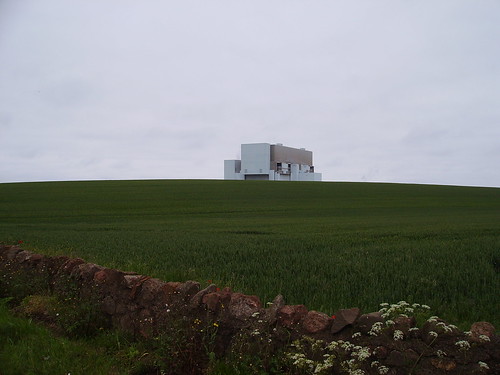.
The Braes Gnomon: windmill
Braes o' Doune, Alexander Maris, 2007
Our field of vision extends into the beyond, but we take comfort in the familiar measure of the near at hand.
– over there
– just a wee way
away
– not far
now
On the scale of plane, vale or hill, which shape our horizons, the eye is irresistibly drawn to known verticals. We navigate by natural and technological landmarks, seeing and saying that the far is coming near.
This there may be home, or a temporary destination. And how different it is to be travelling through a land in which we know no landmarks; how rapidly do we grasp on to anything new that becomes known on such new horizons.

Torness Nuclear Power Station
My body-clock understands how far I am from Edinburgh when I pass the grey hulk of the power station at Torness. The fondness I haven’t been able to prevent myself feeling for this edifice is at odds to the menace that I suppose lies beyond the high searchlight boundary fence.
From the Lothians one marker for north is the fractionated plume from Mosmorran, or at night, the gas flaring against low cloud.
Coming back to Newcastle from the south we have a saying of greeting for the angel:
Watch out!
Gormley about!
Robin can tell where he is on the motorway by this plumb tower.
Robin Klassnik, 2011
On my first trip to Orkney Caroline and I stayed in a cottage on the south tip of South Ronaldsay and all our journeys up the chain of islands to Orkney ‘Mainland’ were marked by the Burray turbine. By the third day it was a familiar topographical timeline signaling we were nearly home.

Burray
Alistair Peebles, 2010
New towers are being raised on the outlying isles –Westray, Flotta, Eday, Sanday and now Rousay – each an aid to alignment; an island mast that identifies folk and their communally held energy solutions. One sees the towers in a swept arc west and north from Mainland Orkney and, for sure, they are also significant new markers for navigating boats and planes – after all, no-one wants to land on the wrong island.
Which only goes to prove that most of us will – whether willingly, or despite ourselves – grow used to and fond of windmills as landmarks: gnomons for places.
(Which isn’t to say some verticals don’t remain widely disliked, as the Duke of Sutherland knows).
The High Road To The Orient
For many of us, the drive north into the Highlands has been given a new zonal marking by the broad array of turbines named ‘Braes o Doune’, on the old grouse- moor. The towers are strung between:
Beinn Odhar
Coire Nochd Mor
Uamh Beag
Hill names that mark the southern extent of Gaelic mountain nomenclature; below these ancient vocables we drift into the lowland tongue, marked by green fields for arable crops:
Cock Hill
The Linns
Loss Hill
Braes o' Doune, Alexander Maris, 2007
The pastoral name that the developers been attached to this windfarm has little to do with the wilderness it is situated within. There are few roses and fewer woodbine here: this is:
WILD
LAND
Braco Recce
From Dunira Alistair and I drove to Comrie and then turned down the old Braco road, following the Romans south over the moor – a somber place in rain or sleet, but on such a September evening, embellished by low sun, the pale bog grasses were luminous against the patched heather.
word mntn (LITTLE HILL)
poem, Alec Finlay; photograph Alistair Peebles, 2011
We wind around Little Hill, me with the map on my lap, but there’s no certainty whether we will see the blades o’ Braes o’ Doune.
word-mntn (CROMLET)
poem, Alec Finlay; photograph Alistair Peebles, 2011
Cromlet – cue our teatime joke for the week, “Cromlet for tea, again” – comes into view, and there the tips are, tirling over the far side of the ridge, beyond the line of the Arrevore Burn.
Braes o’ Doune
Alistair Peebles, 2011
Immense as the Braes o’ Doune installation is – 36 towers, owned by SSE – when viewed from the south, the towers leave less of an impression from the north, being all but hidden in the fold of the hills.
There were some initial environmental concerns about the possibility of pollution caused by the stour lifted by the installation works, affecting the burns that rise here and flow into the River Teith.
On the southern horizon we can see another installation of 13 Vesta towers, on the slopes of the Burnfoot Hill in the Ochils (owned by EDF-ER).
Landscape is always a network of new and old technologies.

Braco
Alistair Peebles, 2011
Proposal for Braes o' Doune
Alec Finlay, 2011; photograph by Alistair Peebles, 2011
A note on terminology
From the correspondence that I had with John Burnside, it seems helpful to distinguishing between small and large-scale windmill turbines, so, to give minimalism and monumentalism, or the domestic and industrial, their due, we live in an era of windmills and wind-towers.
Intimations
Alistair Peebles: Brae projects | blog
.








No comments:
Post a Comment